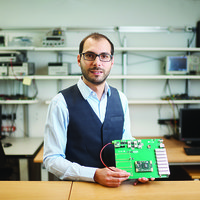Robotics has been in development for over 70 years, yet many technologies in sci-fi movies and novels have not been realized in reality. The robotics field still faces many challenges, such as how to solve its safety when interacting with people, how to improve its adaptability in complex environments, and how to reduce costs.
Huichan Zhao and her collaborators have designed high-energy-density soft actuators to drive a micro flapping-wing aircraft (155mg), and for the first time, a micro aircraft driven by flexible artificial muscles achieved takeoff, hovering, and controllable flight. She also designed hand exoskeletons that take safety, comfort, low cost, and high precision all into consideration, and introduced the rotational casting method into the field of soft robotics, realizing their monolithic fabrication.
During her doctoral studies, Huichan was supervised by Professor Robert Shepherd, a young scientist at Cornell University, engaging in the research of actuation, sensing, and control technologies of soft robots, which can be used in the field of medical rehabilitation. However, traditional sensors cannot fit with the large deformation of the soft actuators. How to build a sensor with high precision, stretchability, repeatability, and stable performance has become a great challenge in the field. Huichan and her collaborators proposed and designed a highly stretchable optical waveguide sensor based on optical signals. Unlike traditional sensors that are based on electrical signals, the optical waveguide sensor is made of rubber, the most common material in the field of soft robotics. Rubber can be embedded in a soft prosthetic hand, which is not only capable of realizing its own position and deformation, but also able of realizing the accurate perception of the hardness, texture, and roughness of external objects.
Aiming at the large deformation sensing problem in the field of soft robotics, Huichan Zhao proposed a sensing scheme based on optical signals, embedding multi-modal sensing functions for soft intelligent prostheses, and realizing the perception of those hands. The related research paper “Optoelectronically Innervated Soft Prosthetic Hand via Stretchable Optical Waveguides” was published in the inaugural issue of Science Robotics.




